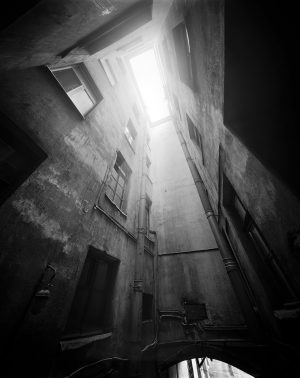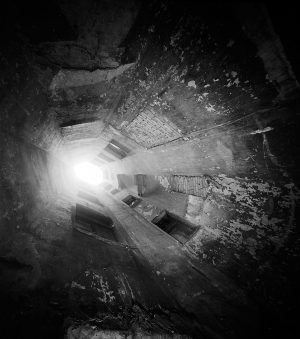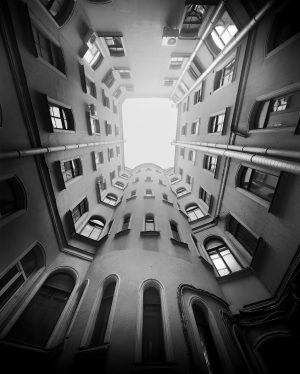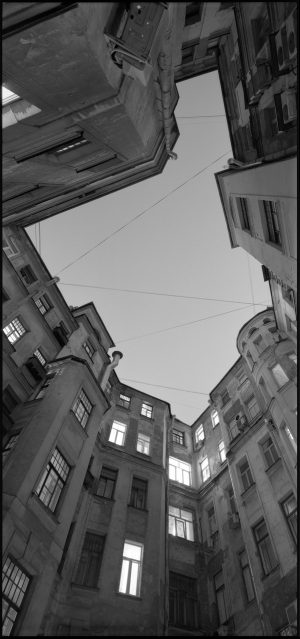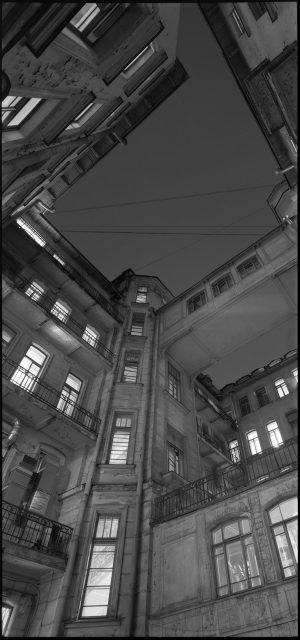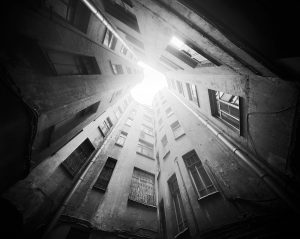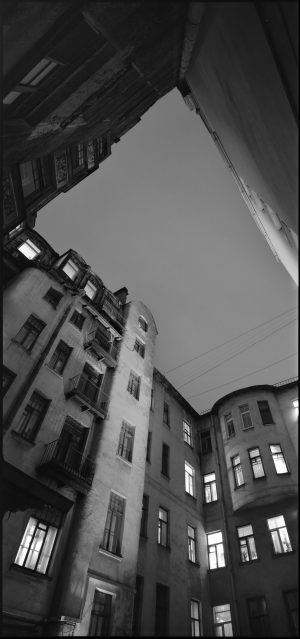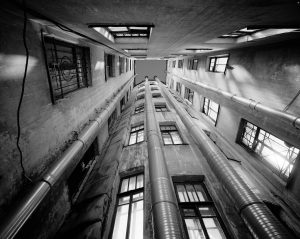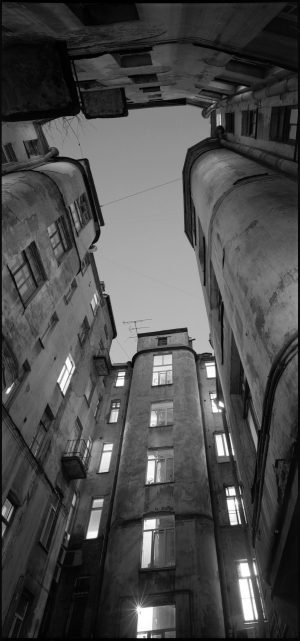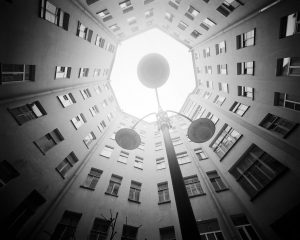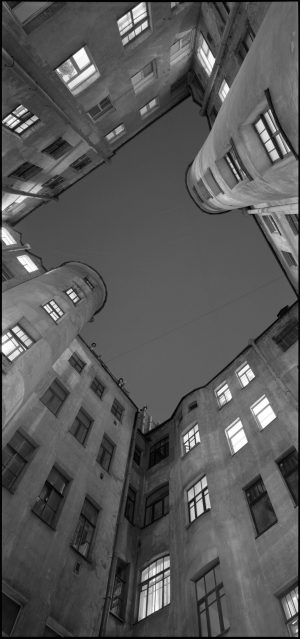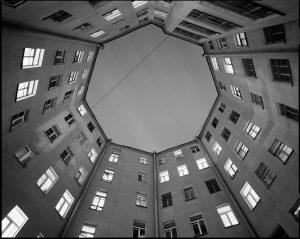Санкт-Петербург. Взгляд снизу.
«Санкт-Петербург. Взгляд снизу» — это вторая часть «проекта-триптиха», демонстрирующего три разных взгляда на город, три самодостаточные и взаимодополняющие про-екции, из которых «вырастает» трехмерная картина городской жизни, его истории и его судьбы. Первая часть проекта была посвящена петербургским крышам (выставка «Санкт-Петербург. Взгляд сверху» прошла в галерее Art of Foto летом 2016 года). Заключительная часть будет связана с петербургскими парад-ными (экспозиция «Санкт-Петербург. Взгляд изнутри» готовится к открытию в 2019 году). Что же касается нынешней, связующей воедино все три части проекта экспозиции под названием
«Санкт-Петербург. Взгляд снизу», то она представляет из себя еще один ракурс, еще одну точку зрения на городское про-странство — из глубины дворов-колодцев, из таинственного мира петербургских подворотен.
Дворы-колодцы встречаются и в других городах мира, но
в таком количестве — только в Санкт-Петербурге. Не случайно, двор-колодец считается одним из символов нашего города
(наравне с дворцами, каналами, мостами и фонтанами). Правда, в отличие от пышных дворцовых ансамблей, парадных площа-дей, гранитных набережных и разводных мостов, дворы-колод-цы символизируют не экскурсионный, выставочный и офици-альный, а неформальный, скрытый от глаз Петербург.
Получается, что дворы-колодцы — эдакая изнанка города. У них иное предназначение, иной смысл и даже иная геометрия. Если парадный Петербург — это следующая за «небесной линией» горизонталь, то дворы-колодцы — это вертикальные, устремленные в небо пространства, изначально предназначенные не для созерцания, а для ежедневной, «черновой», часто тяжелой и неприглядной жизни.
История внутренних дворов неразрывно связана с возникнове-нием в Петербурге предназначенных для сдачи квартир в арен-ду доходных домов. Эти, выходящие на улицы и проспекты своими величественными фасадами, сооружения скрывают
за собой целые лабиринты дворов-колодцев. Здесь когда-то располагались подсобки, склады с углем и дровами, конюшни и выгребные ямы. Сюда же выходили черные лестницы, кото-рыми пользовались небогатые жильцы верхних этажей, а также прислуга. Самые узкие дворы-колодцы также использовались в качестве вентиляционных шахт.
Бум строительства доходных домов случился в Петербурге на рубеже XIX–XX вв. С тех пор и существует это негласное разде-ление, на «парадный Петербург» — город площадей, набереж-ных и проспектов — и «скрытый город» подворотен, а после 1917 года еще и коммунальных квартир, которые выходили своими окнами в многочисленные дворы-колодцы. Изучением семантики этих пространств, их связи с городом и его историей, а также фотосъемкой наиболее «сильных» по ряду критери-ев (текстура стен, высота двора и его геометрия, освещенность и пр.) дворов-колодцев и занимались авторы экспозиции, фото-графы Вадим Левин, Игорь Смольников и Роман Землячев.
«В разное время, осенью и весной, в течение трех или четырех недель, мы изучали, выбирали и фотографировали петербург-ские дворы-колодцы, — рассказывает один из авторов выставки Роман Землячев, — Нам нужен был режимный свет, поэтому снимали утром или вечером до наступления сумерек. Съемка проходила на длинной выдержке — до 40 минут, и за один раз удавалось сделать всего два или три кадра. Любопытно, что уже потом, на стадии печати, несколько кадров пришлось забраковать, поскольку под некоторыми из дворов проходят линии метро, и незаметная для человека вибрация сказалась на качестве изображений».
«Во время работы над этой серией мы очень остро чувство-вали, что у каждого двора-колодца есть не только своя исто-рия, но и свой характер. Лично мне запомнились две точки съемки, — продолжает свой рассказ фотограф, — Во-первых, это подвесной двор дома на Кирочной улице (речь идет о так называемом доходном доме Юлиана Бака, который был построен в 1905 году и находится по адресу Кирочная, 24 — прим. Art of Foto). Над этим двором нависают крытые галереи. В темное время они совершенно фантастически святятся своими окнами. Адрес еще одного двора я называть не буду, поскольку, когда мы пытались сделать там снимок, на нас чуть ли не с кула-ками набросилась охрана расположенного там же театра. К счастью, победа осталась за нами, и сделать кадр удалось».
С петербургскими дворами связано не мало мистических исто-рий. И если в древности колодцы, из которых брали воду, счи-тались некими «порталами», связующими миры людей и духов, то по аналогии с ними петербургские дворы-колодцы можно считать столпами, поддерживающими связь между прошлым и будущим нашего города. В представленных на выставке
«Санкт-Петербург. Взгляд снизу» работах явственно ощущается преемственность настоящего и прошлого, связь мимолетного и вечного. Построенные больше века назад дома, их потрескавшиеся стены на нерукотворном фоне петербургского неба, геометрия линий крыш, игра падающего из окон света — все эти детали и формы позволяют открыть для себя невиданную ра-нее красоту скрытого от глаз непосвященных туристов города.
текст: Даниил Ширяев
Saint-Petersburg. A Glance from Below.
«Saint-Petersburg. A Glance from Below» is a second part of the «project-triptych», which demonstrates three different points of view on the city, three self-sufficient as well as complimentary projections, which «develop» together a three-dimensional image of the city life, its history and des- tiny. The first part of the project was dedicated to the roofs of Saint-Petersburg (the exhibition «Saint-Petersburg. A Glance from above» was held in Art of Foto in the summer 2016). The final part will be on the entrances of the city (the exposition «Saint-Petersburg. A Glance from the inside» is being prepared to open in 2019). But in what regards the actual exposition, which links together all three parts, it represents one more an- gle, one more point of view on the city space — from the depth of well-type courtyards, from mysterious world of Saint-Peters- burg’s backstreets.
One can find well-type courtyards in other cities of the world as well, but so many of them are located only in Saint-Petersburg. This is why, and it is not a coincidence, that a welltype courtyard is considered one of the symbols of our city (together with pal- aces, canals, bridges and fountains). To be honest, compared
to splendid palaces, granite quays and swing bridges, those well-type courtyards symbolize another Saint-Petersburg, not the official, sightseeing one, but hidden and informal. So, well- type courtyards are a kind of city’s inside. They have another purpose, another sense and even another geometry.
While gala Saint-Petersburg is a horizontal line following the «sky line», well-type courtyards are something else, in particu- lar — vertical, striving to reach the sky spaces, initially designed not for contemplation, but for everyday «rough», often tough and charmless life.
The history of inside courtyards is tightly linked to the time when so-called «revenue houses» (buildings including apart- ments for rent) appeared in Saint-Petersburg. These colossal buildings, that have their majestic facades open onto the streets and prospects, hide labyrinths of well-type courtyards. Some time ago different kinds of supply closets, warehouses with coal and firewood, cesspools were located here. Also such court- yards were an entrance for service stairs which were used by not-so-reach residents of upper floors as well as servants. The narrowest well-type courtyards could also be used as a kind of air trunk.
The rise in construction of revenue houses took place in Saint-Petersburg in XIX — XX centuries, and after that there exists this unspoken division of «parade city» — with its squares, quays and avenues — and «hidden city» of backstreets, and after the year 1917 — the city of communal flats, which had their windows open onto numerous well-type courtyards. The study of semantics of those spaces, their connection to the city and its history as well as photography of the most «powerful» according to a number of criteria (wall texture, the height of the courtyard and its geometry, illumination etc) well-type court- yards — that’s what the authors of the exposition, photographs Vadim Levin, Igor Smolnikov and Roman Zemlyachev were occu- pied with lately.
«We were exploring, choosing, making photographs of well- type courtyards of Saint-Petersburg during different periods in autumn and spring for three or four weeks, — says Roman Zemlyachev, one of the authors of the exposition, — We needed some kind of regime light, so we had to shoot in the morning or in the evening, before the twilight. The shooting took place on a long exposure, about 40 minutes, and we could only make two or three frames during one shooting. It’s interesting that only after, during printing, we had to reject several frames because there was underground under some of our courtyards and vibration, completely imperceptible for a man, affected the quality of our images».
«When working on this series we were feeling very vividly, that every courtyard not only has its own history, but also its own character. Personally I remember two shootings — continues
the photograph — first is a suspended courtyard on Kirochnaya street (we are speaking here about the revenue house of Julian Bak, built in 1905 and located on Kirochnaya, 24 — com. by Art of Foto). There are roofed galleries hanging over this court- yard. In night-time they are enlightened by their windows and it looks fantastically. I will not mention the address of another courtyard, because when we tried to shoot there, guards of the theatre located in the courtyard almost attacked us. Luckily, the victory was ours — we managed to make a photograph».
Courtyards of Saint-Petersburg are involved in a number of mys- terious stories. In ancient times wells, that were used for finding potable water, were believed to be a kind of «portals» connect- ing the world of men with a world of spirits, and likewise today well-type courtyards can be regarded as pillars, supporting the connection between the past and the future of our city. Photographs, presented on the exposition «Saint-Petersburg. A Glance from Below», clearly have a sense of succession be- tween the present and the past, the connection between imper- manence and immortal. The houses, built more than a century ago, their cracked walls against the genuine background of Saint-Petersburg’s sky, the geometry of roof lines, the game of light coming out the windows — all those details and forms help one open for himself a brand new beauty of the city, hidden from tourists.
text: Daniil Shiryaev
Видео о наших съемках этого прроекта


